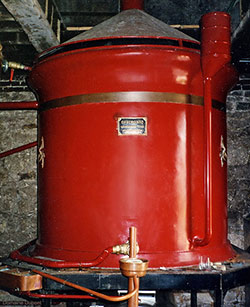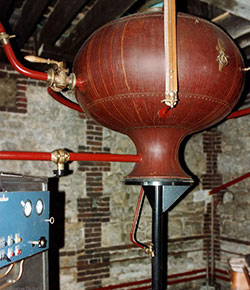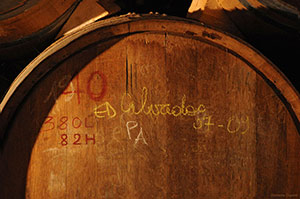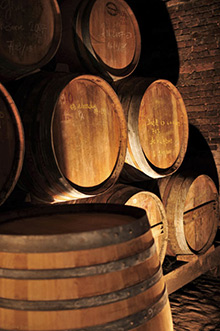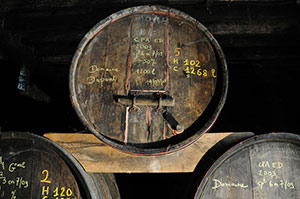Distillation and Aging of Calvados
Preserving the character of the apple and its terroir
The Distillation of Calvados:
After a slow, two months long fermentation, the cider destined to become calvados is aged six months on its fine lees to enhance its aromatic expressiveness. There must be no hint of taint in the aromas so that a perfect expression of calvados can be obtained.
The Domaine Dupont alembic allows flexibility and precision during the distillation. This permits the extraction of all the scents from the cider, and gives the spirit its qualities of silky finesse.
The principle of distillation is to separate the alcohol from the water, thanks to the difference in their boiling points. When the temperature of the cider reaches 80°C (176°F) only the aromatics and alcohol escape in a flow of steam. The intensity of the fire influences the rapidity of the steam flow, and the height and diameter of the swan neck determine the speed and length of its travel.
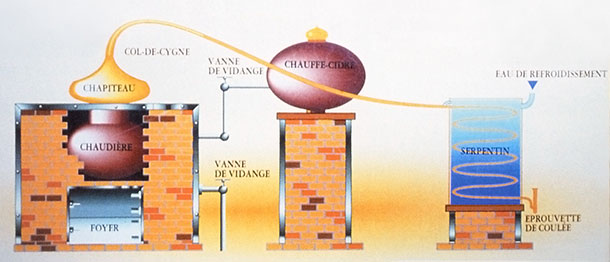
From the book "Calvados" by Henrik Mattsson - Visit website
(reproduced with permission of the author)
Note: Double distillation in a pot still gives a much higher quality eau-de-vie than that produced using the more recent continuous Coffey still ("Alamabic à colonnes") which however is quicker and cheaper to run.
The cider is poured into the pre-heater ("chauffe-cidre") and is then transferred to the heating-vessel ("chaudière") where it reaches 80°C (176°F). The steam passes through the swan's neck ("col-de-cygne"), and thence back to the pre-heater ("chauffre-cidre") where it heats a new batch of cider, and then passes into the condenser: a coiled copper pipe ("serpentin") surrounded by a copper tank of cold water. The process is repeated a second time with the distillate from the first process.
This "petite eau" is distilled a second time, (called the "bonne chauffe" or good heating) to give Calvados. Care is taken to separate out the part that first evaporates and is too strong (the headings) and the part which appears last, containing less that 60% by volume which are heavy and lack in finesse (the tailings). Only the heart of the Calvados, which contains alcohol levels between 60 and 80% by volume is conserved. During this stage of distillation, the heating must be carried out swiftly, so that the flow of steam carries as many of the congenerics with it as possible beyond the swan neck.
The aging of calvados:
The choice of the right barrels is at the heart of good aging and aromatic complexity. At the Domaine Dupont oak is the preferred wood, more particularly oak which has grown on sandy soil, because its sap has a flavour of vanilla which marries harmoniously with the aromas of freshly distilled Calvados. The barrels are only heated gently when shaped, to preserve the vanilla aromas in the sap.
The aging in young barrels lasts about 3 months, sufficient to enrich the Calvados with the vanilla aromas from the wood, without letting it mask the taste and aroma of the apples from which it came. Subsequently, the Calvados continues its aging in older barrels, less rich in tannins. Passing through the pores of the wood, the most volatile alcohol evaporates over time, the aromas intensify, gain in complexity and become more concentrated. The Calvados progressively approaches the alcoholic strength at which it will be consumed.
Etienne Dupont encourages this evaporation as much as possible to avoid all other additions, and to avoid as much as possible the reduction of alcoholic levels by the addition of water. That is why some calvados from the estate are sold "unreduced" (undiluted).
Slowly, the floral and vegetal characters of the Calvados bouquet become more complex. As it ages, the Calvados finds its roots again. Colourless as it leaves the alembic, it takes on an ever increasingly amber colour, while the development of sugars, essential oils, and fatty acids gives it ever increasing roundness, intensity and fullness.
Young Calvados, with their fruity bouquet are agreeable as aperitifs or even throughout the meal when accompanying some kinds of food. They also make very convivial post prandial drinks. Older Calvados are in themselves a great tasting experience. They demand time to be taken to appreciate all the complexity of their bouquet. The silkier ones are best sipped unaccompanied. Those with more intense aromas can be drunk on their own, or can brilliantly accompany well chosen coffee, or chocolate with a high cocoa content, or yet a cigar carefully selected by the knowledgeable amateur.

